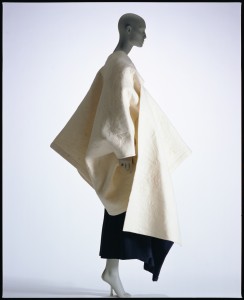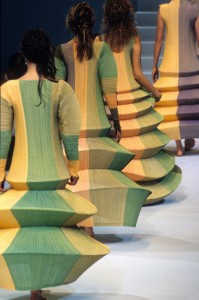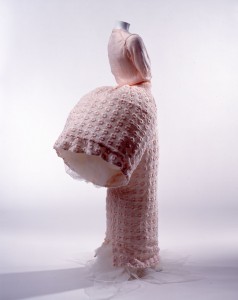 Under no pretext should you miss Future Beauty: 30 Years of Japanese Fashion at Barbican Art Gallery. Curated by the Japanese fashion historian Akiko Fukai, Director of the Kyoto Costume Institute (KCI), the exhibition covers 30 years of avant-garde japanese fashion, from the early 1980s to now. It is also the first time in England that a gallery displays the Kyoto Costume Institute’s legendary collection, showcasing the works of Japan’s greatest designers from masters like Issey Miyake, Rei Kawakubo and Yohji Yamamoto, to internationally acclaimed Junya Watanabe and Jun Takahashi, to the daring and highly innovative new generation, including Tao Kurihara, Matohu and Mintdesigns.
Under no pretext should you miss Future Beauty: 30 Years of Japanese Fashion at Barbican Art Gallery. Curated by the Japanese fashion historian Akiko Fukai, Director of the Kyoto Costume Institute (KCI), the exhibition covers 30 years of avant-garde japanese fashion, from the early 1980s to now. It is also the first time in England that a gallery displays the Kyoto Costume Institute’s legendary collection, showcasing the works of Japan’s greatest designers from masters like Issey Miyake, Rei Kawakubo and Yohji Yamamoto, to internationally acclaimed Junya Watanabe and Jun Takahashi, to the daring and highly innovative new generation, including Tao Kurihara, Matohu and Mintdesigns.
Japanese designers made an enormous impact on world couture in the eighties by challenging established Western aesthetics. Rejecting the then obsession with body-consciousness, whether it be in terms of colours, shapes or fabrics, they invented a whole new language. With a focus on concealing the body rather than revealing it, they radically changed the face of fashion.
Kate Bush, Head of Art Galleries, Barbican Centre, said: « The great Japanese designers – Rei Kawakubo, Issey Miyake and Yohji Yamamoto – changed fashion forever in the 1980s. The tight silhouettes of Western couture were jettisoned for new fluid shapes. Out went the magnificent ornament and extravagant techniques of the post-war tradition and in came a stark, monochrome palette and an entirely new decorative language – holes, rips, frays and tears – emerging from the stuff of fabric itself. I am delighted that Barbican Art Gallery is the first gallery in Europe to chart this fascinating and influential period in design history. »
The first section of the lower galleries, In Praise of Shadows, focuses on the three pioneers – Miyake, Kawakubo, Yamamoto – and, having in mind the aerobic culture of the eighties, it is pretty easy to understand why the black or white fluid dresses on display here were considered as revolutionary. Such a strong avoidance of colour and use of deconstructed shapes could have hardly stayed unnoticed. From a wonderful black and dark blue dress by Rei Kawakubo for Comme Des Garcons (A/W 83-84) to an impressive black nylon taffeta coat, it is a perfect celebration of the beauty and power of black as a colour.
Next, Flatness explores the work around volume and geometry in Issey Miyake and Rei Kawakubo’s creations, including the mythic pleats garments, launched in the early nineties, and which combined traditional shobori tie-dying and modern fabrics.
Tradition is explored further in the third section, or more specifically how traditional Japanese garments and techniques, such as kimono and origami, have been radically reinvented through the technological advances in textile. Non woven fabrics, kraft-paper, bright-coloured nylon nets, we have definitely landed in a much more techno world. This section includes paper garments by TAO, OhYa and Mintdesigns, examples of Kawakubo’s deconstructionist work, Watanabe’s seminal A/W 2000 collection Techno Couture, but also modern takes on traditional Japanese techniques and garments by Yamamoto, Kenzo and Matohu.
Cool Japan, the final section of the lower galleries, virtually takes us to the famous Shibuya area in Tokyo, focussing on influences of street style in high fashion.
The upper galleries of Future Beauty allow us to go even further in the exploration of Japanese fashion, with individual presentations of the principle designers’ works, featuring a range of archive and recent works: Rei Kawakubo, Yohji Yamamoto, Issey Miyake, Junya Watanabe, Jun Takahashi and Tao Kurihara, as well as Mintdesigns and a number of emerging designers such as Akira Naka, Anrealage, Né-Net, Sacai, Somarta, Mikio Sakabe, and Taro Horiuchi. Whilst the lower galleries are more didactic, this part of the exhibition is all about pleasure and wonder. Some of the most iconic and breath-taking creations by the great names of Japanese fashion are displayed here. For your eyes only!
And if you want even more – and it is very likely you will – a great programme of talks, performances, workshops and lively late night events with emerging and high profile practitioners, leading writers and historians accompanies the exhibition. More information at www.barbican.org.uk/artgallery
Laurie Guillem
Future Beauty: 30 Years of Japanese Fashion – 15 October 2010 – 6 February 2011 – Barbican Art Gallery, London



